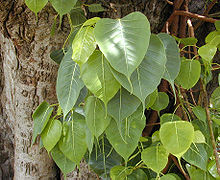Ficus religiosa
| Sacred fig Ficus religiosa |
|
|---|---|
 |
|
| Leaves and trunk of a sacred fig. Note the distinctive leaf shape like a heart. |
|
| Scientific classification | |
| Kingdom: | Plantae |
| (unranked): | Angiosperms |
| (unranked): | Eudicots |
| (unranked): | Rosids |
| Order: | Rosales |
| Family: | Moraceae |
| Genus: | Ficus |
| Species: | F. religiosa |
| Binomial name | |
|
Ficus religiosa L. 1753 not Forssk. 1775 |
|
| Synonyms | |
|
|
Ficus religiosa or sacred fig is a species of fig native to the Indian subcontinent, and Indochina. It belongs to the Moraceae, the fig or mulberry family. It is also known as the bodhi tree,pippala tree, peepul tree,peepal tree or ashwattha tree (in India and Nepal).
Ficus religiosa is a large dry season-deciduous or semi-evergreen tree up to 30 metres (98 ft) tall and with a trunk diameter of up to 3 metres (9.8 ft). The leaves are in shape with a distinctive extended drip tip; they are 10–17 cm long and 8–12 cm broad, with a 6–10 cm petiole. The fruits are small figs 1–1.5 cm in diameter, green ripening to purple. The leaves of this tree move continuously even when the air around is still and no perceptible wind is blowing. This phenomenon can be explained due to the long leaf stalk and the broad leaf structure. However, religious minded people in Hindu/Buddhist religion attribute this movement of the leaves to the fact that "devas" or "gods" reside on these leaves and make it move continuously.
The Ficus religiosa tree is considered sacred by the followers of Hinduism, Jainism and Buddhism. In the Bhagavad Gita, Krishna says, "I am the Peepal tree among the trees, Narada among the sages, Chitraaratha among the Gandharvas, And sage Kapila among the Siddhas."
Gautama Buddha attained enlightenment (bodhi) while meditating underneath a Ficus religiosa. The site is in present-day Bodh Gaya in Bihar, India. The original tree was destroyed, and has been replaced several times. A branch of the original tree was rooted in Anuradhapura, Sri Lanka in 288 BCE and is known as Jaya Sri Maha Bodhi; it is the oldest flowering plant (angiosperm) in the world.
...
Wikipedia
